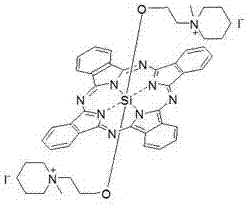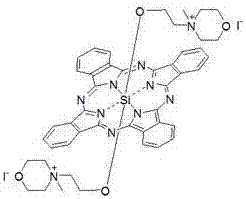A silicon phthalocyanine with an axial ester bond linking piperidine or morpholine derivatives
A morpholine derivative, silicon phthalocyanine technology, applied in the field of photodynamic drug or photosensitizer preparation, can solve the problems of limited clinical application, complex synthesis route, high skin phototoxicity, etc., and achieves improved tissue penetration ability and clear structure. , easy to prepare
- Summary
- Abstract
- Description
- Claims
- Application Information
AI Technical Summary
Problems solved by technology
Method used
Image
Examples
Embodiment 1
[0037] Synthesis and physicochemical properties of bis[3-(N-piperidine)propyl]silicon phthalocyanine (structure shown in the following formula):
[0038]
[0039] Under the protection of nitrogen, add dichlorosilicon phthalocyanine (244.7mg, 0.4mmol), 3-(N-piperidine) propionic acid 1.2-2.4mmol (preferably 2.0mmol) to toluene or xylene or dioxane 20 -50ml (preferably toluene, 30ml), reflux for 20-36 hours (preferably 24 hours). The solvent was removed by vacuum rotary evaporation, dissolved in 100ml of dichloromethane, centrifuged to remove insolubles, the dichloromethane solution was extracted with water (3×100ml), the organic layer was collected, and then extracted with dilute hydrochloric acid (0.1-0.5mmol), and the aqueous layer was collected. The water layer was neutralized with 1M sodium hydroxide, a blue precipitate was precipitated, centrifuged, washed with water, and dried in vacuum to obtain a blue product with a yield of 45%. The maximum absorption peak of the product...
Embodiment 2
[0042] Synthesis and physicochemical properties of bis[3-(N-methyl-N-piperidine)propyl] silicon phthalocyanine diiodide (structure shown in the following formula):
[0043]
[0044] Under the protection of nitrogen, add bis[3-(N-piperidine)propyl]silicon phthalocyanine (0.023mmol) and excess methyl iodide to chloroform (20ml), reflux for 1~4 hours (preferably 2 hours) Stir at room temperature for 16 to 48 hours (preferably 24 hours). After filtration, the filter cake was washed three times with 50 ml of chloroform, and dried under vacuum to obtain the product with a yield of 73%. The maximum absorption peak of the product in DMF is at 684nm, and the maximum absorption wavelength in aqueous solution is at 691-700nm.
[0045] The structural characterization data of the product are as follows: HR-MS (ESI) m / z: 441.1888 [M-2I] 2+ ; 1 H NMR(DMSO-d6, 400MHz, ppm): δ9.70~9.82 (m, 8H, Pc-H α ), δ8.55~8.66 (m, 8H, Pc-H β ), δ2.14~2.25 (m, 4H, 3-H), δ1.98~2.09 (m, 4H, 3-H), δ1.74~1.85 (s, 6...
Embodiment 3
[0047] Synthesis of bis[3-(N-morpholine)propyl]silicon phthalocyanine (structure shown in the following formula):
[0048]
[0049] Under the protection of nitrogen, add dichlorosilicon phthalocyanine (244.7mg, 0.4mmol), 3-(N-morpholine) propionic acid 1.2-2.4mmol (preferably 2.0mmol) to toluene or xylene or dioxane 20 -50ml (preferably toluene, 30ml), reflux for 20-36 hours (preferably 24 hours). The solvent was removed by vacuum rotary evaporation, dissolved in 100ml of dichloromethane, centrifuged to remove insolubles, the dichloromethane solution was extracted with water (3×100ml), the organic layer was collected, and then extracted with dilute hydrochloric acid (0.1-0.5mmol), and the aqueous layer was collected. The water layer was neutralized with 1M sodium hydroxide, and a blue precipitate was precipitated, centrifuged, washed with water, and dried in vacuum to obtain a blue product with a yield of 43%. The maximum absorption peak of the product in DMF is located at 681 n...
PUM
| Property | Measurement | Unit |
|---|---|---|
| wavelength | aaaaa | aaaaa |
| wavelength | aaaaa | aaaaa |
Abstract
Description
Claims
Application Information
 Login to View More
Login to View More - R&D
- Intellectual Property
- Life Sciences
- Materials
- Tech Scout
- Unparalleled Data Quality
- Higher Quality Content
- 60% Fewer Hallucinations
Browse by: Latest US Patents, China's latest patents, Technical Efficacy Thesaurus, Application Domain, Technology Topic, Popular Technical Reports.
© 2025 PatSnap. All rights reserved.Legal|Privacy policy|Modern Slavery Act Transparency Statement|Sitemap|About US| Contact US: help@patsnap.com



